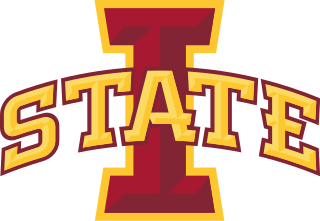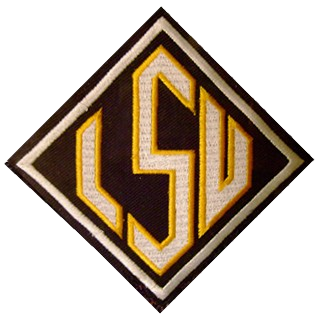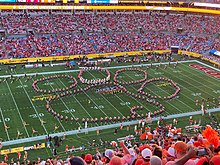
The Cavalier Marching Band (CMB) is the marching band at the University of Virginia. The band's original director, William "Bill" Pease, was the first full-time marching band director in the history of the University of Virginia. The Cavalier Marching Band made its debut on September 11, 2004, after a considerable donation was made by University of Virginia benefactors Carl and Hunter Smith to found the band in 2003. The CMB uses a mixture of both DCI style glide step and high step in its performances. Of its 200 members, all seven undergraduate schools at the University of Virginia are represented.

"Tiger Rag" is a jazz standard that was recorded and copyrighted by the Original Dixieland Jass Band in 1917. It is one of the most recorded jazz compositions. In 2003, the 1918 recording of "Tiger Rag" was entered into the U.S. Library of Congress National Recording Registry.

The Sun Devil Marching Band (SDMB), also known as The Pride of the Southwest, is the athletic band of Arizona State University in Tempe, Arizona. The Sun Devil Marching Band motto is “Expect Great Things.” The acronym EGT is inscribed on a sign that hangs from the director's podium towering over the band's practice field, and is a symbol of the high standards that band members strive to meet. The ASU Band program, which includes the Marching, Pep, and Dixieland bands, is a part of the Sun Devil Athletics department. The band is currently under the direction of Director of Athletic Bands James G. "The Hammer" Hudson, who took over the program in 2006. The Sun Devil Marching Band is a major ambassador for Arizona State University and the state of Arizona. Each year almost 500,000 people are entertained by the band, which plays at home football at Sun Devil Stadium and as a pep band for basketball games at Wells Fargo Arena, homecoming, bowl game parades, other community events in the Valley, across the country, and even abroad.

The University of Massachusetts Minuteman Marching Band (UMMB) is the marching band for the University of Massachusetts Amherst known for its drum corps style and nationally renowned percussion section. The Minuteman Band is also known for its use of dance routines, vocalists, electronics, and overall showmanship.

Formed in 1845, the Holy Cross Goodtime Marching Band is one of the oldest organizations at The College of the Holy Cross in Worcester, Massachusetts, USA, and one of the oldest college bands in the United States. The Crusaders Marching Band first began performing at football games in 1910 and the band's role has expanded significantly since to include other athletic appearances, performing at all home football games, selected away games, in exhibition at high school band competitions, and at various events throughout the country. In the spring, the marching band converts into the Holy Cross Crusader Pep Band and plays at all home basketball games, and travels with the teams to the NCAA tournament. The Marching Band performs at Fitton Field while the Pep Band plays in the Hart Center.

The Hawkeye Marching Band is the marching band for the University of Iowa. The band performs at all home Hawkeye football games at Kinnick Stadium in addition to other events. It is the largest and most visible musical ensemble at the university. The band was founded in 1881 as a military band, giving membership to both music students and members of the military. In 1990, the band was awarded the Louis Sudler Intercollegiate Marching Band Trophy, generally considered to be the most prestigious honor a collegiate marching band can receive.

The University of Minnesota Marching Band is the marching band of the University of Minnesota and the flagship university band for the state of Minnesota. The Pride of Minnesota serves as an ambassador for the university, representing the school at major events both on and off campus. The band performs before, during, and after all home Golden Gopher football games and bowl games, occasional away games, local parades, numerous pepfests, exhibition performances, as well as a series of indoor concerts toward the end of the regular football season. Members of the band, along with non-member students, also participate in smaller athletic pep bands that perform at other major sporting events, including men's hockey, men's basketball, women's hockey, women's basketball, and women's volleyball.
The University of Pittsburgh Varsity Marching Band, or Pitt Band, is the college marching band at the University of Pittsburgh. The band numbers over 300 students consisting of instrumentalists, a majorette squad known as the Golden Girls, a color guard, and the drumline. The band was founded in 1911 and has won numerous awards over the years. All members of the band must pass an audition in order to join. The band is currently housed in Trees Hall; however, in 2020, the Pitt Athletic Department announced its "Victory Heights" initiative, part of the campus master plan which includes a new marching band facility slated to open in spring 2027.

The Iowa State University Cyclone Football 'Varsity' Marching Band (ISUCF'V'MB) is the marching band of Iowa State University. Also known as the Cyclone Marching Band (CMB), it is nicknamed the "Pride of Iowa State", the "Best of the Midwest", and the "Varsity Band". The band performs in support of the Iowa State Cyclones football team at all home games and at some away games versus Big 12 Conference rivals. The band plays at high school band festivals, indoor concerts, and post-season bowl games.

Marching Mizzou, M2, or The Big 'M' of the Midwest is the performing marching band for the University of Missouri, founded in 1885 as a college military band. Originally consisting of only 12 members, it is now the largest student organization on the MU campus, drawing students from nearly every major. Marching Mizzou performs at all home football games of the Missouri Tigers football team, in addition to other university events; and expanded Mini Mizzou travels to two away games per season, while the entire band regularly follows the team to conference championship games and bowl games. Marching Mizzou's signature drill "Flip Tigers" has been a well-known tradition of its pre-game show since 1960. It is instructed by University of Missouri School of Music faculty.

The Marching Jayhawks, is a 380-piece marching band consisting of woodwinds, brass, percussion, and color guard, representing the University of Kansas in Lawrence, Kansas. The band performs at all home football games and occasionally travels to away games. They also send smaller ensembles to pep rallies around the Kansas City area. The band marches in parades on campus and in downtown Lawrence. The volleyball and basketball pep bands play at all home games and will often travel for post-season play.

The Louisiana State University Tiger Marching Band is the marching band of Louisiana State University (LSU). The band has 325 members and performs at all LSU football home games, all bowl games, and away games.

The Thunder of the East is the marching band of the University at Buffalo in the State University of New York system. UB's first marching band was created in 1920, and disbanded in 1927. It was revived in 1946, increasing in size and reputation until about 1970. It was known as "The Pride of the East." At that time, it was dissolved upon UB's departure from Division I athletics. In 1981, some UB students continued the tradition of playing music at UB's home football and basketball games by forming UB's Pep Band. In anticipation of UB's return to Division I athletics, a marching band was formed in 1999 and named, "Thunder of the East." The band debuted at the University at Buffalo Stadium on September 11, 1999. The Thunder of the East is currently led by James E. Mauck; and performs at UB's Buffalo Bulls home football games, as well as in other musical venues.
The Georgia Redcoat Marching Band, commonly referred to as "The Redcoats", is the official marching band of the University of Georgia.

The University of Cincinnati Bearcat Bands make up the university's athletic band program and are distinct and separate from the College Conservatory of Music. The Bearcat Bands serve as both an academic class and a student group as an independent department within the Division of Student Affairs.
The Boston College Marching Band (BCMB), also known as the Boston College "Screaming Eagles" Marching Band, is the marching band for the Boston College Eagles. Founded in 1919, The Band is the largest and most visible student organization at Boston College, and represents the school at home football games, most bowl games, international events, and parades.

The Carolina Band, or the Mighty Sound of the Southeast, is the official marching band of the University of South Carolina. With an average membership of 360, it is the largest ensemble associated with the university's School of Music. The marching band performs at all South Carolina Gamecocks football home games played at Williams-Brice Stadium, as well as neutral site games, bowl games, and all games against Clemson, where both the Carolina Band and Clemson's Tiger Band both perform at half time regardless of which school is hosting on a given year.

The Syracuse University Marching Band (SUMB), also known as the Pride of the Orange, is the collegiate marching band of Syracuse University. The band consists of approximately 200 members. The SUMB performs at all home Syracuse Orange football games throughout the season in the Carrier Dome, and also takes part in parades and other performances throughout the year. It is one of the largest student organizations at Syracuse University, and one of the oldest collegiate bands in the United States.

Louisiana State University is the flagship university of the state of Louisiana, United States. This article describes the traditions of the university.
The Duke University Marching Band (DUMB) is the marching band of Duke University, located in Durham, North Carolina. The band performs at all Duke Blue Devils football home games, select away games, bowl games, and other events. The band also supports various other sports in the form of a pep band. Band membership consists almost entirely of non-music majors and includes roughly 150 participating students. First founded in 1906, the group is very significant for being one of the oldest marching bands in the Atlantic Coast Conference. In 2012, they produced and released their own album, Gameday Faves: Duke Classics, containing favorite music selections of the band and university.

















